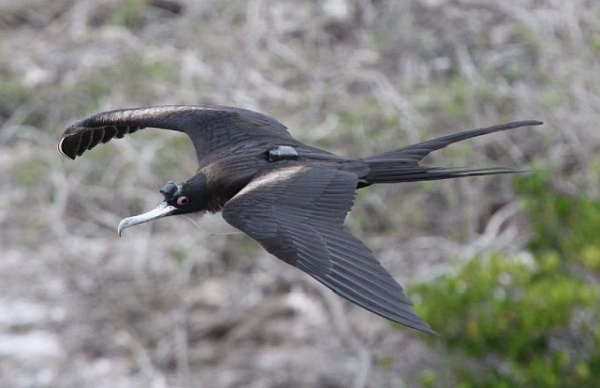
8 August 2016
On transoceanic airplane trips the passengers try to sleep in flight but the pilots stay awake. (Thank heaven!) Many birds, including swifts, sandpipers and songbirds, fly non-stop over the ocean for so long that scientists guessed the birds would have to sleep along the way. But how? Wouldn’t they crash?
As part of their daily lives, great frigatebirds (Fregata minor) fly non-stop for weeks, eating flying fish and ocean-surface food in trips that can span two months and 22,000 miles. These large birds live over the ocean but not on it because their feathers aren’t waterproof.
Great frigatebirds have got to sleep some time so researchers led by Niels C. Rattenborg of the Max Planck Institute fitted more than a dozen females with instruments to measure sleep and flight time. The great frigatebird, above, has a sleep-measuring headset and a GPS backpack.
The results of the sleep study were surprising.
Scientists knew that, on land, birds can sleep with only half the brain while the other half stays alert for danger. They found that great frigatebirds half-sleep in the air, too, but sometimes both hemispheres sleep at once for more than two minutes. They do it while circling on an updraft.
Another surprise was how little the birds slept, clocking only 42 minutes/day in the air compared to 12 hours/day on land. If they were humans they’d be seriously sleep deprived.
Amazingly the frigatebirds’ performance was not affected by lack of sleep and when they got home they caught up on sleep in their first days on shore. How many of us wish we could live like that!
Find out more here at Gizmodo or in the report here in Nature Communications.
(photo of great frigatebird with sleep measuring equipment by Bryson Voiron from “Evidence that birds sleep in flight,” Nature Communications)